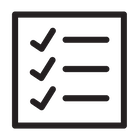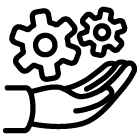Resource Crosswalk
The resources presented in this Crosswalk lend support to state partners, including the state agencies, state support teams, and educational services centers by providing professional learning, technical assistance, coaching, and implementation supports.
Explore the Crosswalk by selecting the content areas on the left navigation below and then select the resources appearing to the right to learn more.
Increase Knowledge
The following resources lend support to building knowledge and understanding of topics related to postsecondary transition.
| Description | Type | Length | Certificate |
|---|---|---|---|
Access to the General Education Curriculum/Literacy Access for ALLThis FREE, 10-part video series containing over 70 coaching videos and hundreds of resources explores strategies grounded in research that are designed to ensure ALL learners have access to the general curriculum. |
 |
 |
 |
Age-Appropriate Transition Assessment Planning GuideThroughout this guide, you will be introduced to the planning process for transition assessment. It is important we intentionally plan for transition assessment to ensure we reduce duplication, build on a student’s progress, and identify individualized assessment to build the youth’s profile in relationship to those skills needed for their adult life goals. |
 |
 |
|
Agency Navigation ToolThe document and supporting video were created as a resource to provide basic information about key agencies. This document contains: A list and description of the types of information that agencies often request. A brief overview of key agencies that includes information or resources about topics such as: eligibility requirements, intake procedures, and possible services .Contact information and helpful websites for each state or federal agency. Space to add local contact information for each agency. A space for families/teams to record the information about the youth or family that is often requested by agencies. |
 |
 |
|
Assistive Technology Internet Modules (ATIM)ATIM include 58 interactive learning modules on topics related to AT including but not limited to resources about, assessment, implementation, transition, and AT for specific curricular areas and areas of independent living. |
 |
 |
 |
AT DevicesThe OCALI AT Lending Library contains a wide range of assistive technology devices, AT kits, and FM/DM systems and that can be borrowed by Ohio school districts and other agencies who support persons with disabilities to assist in the AT assessment process by providing hands-on trials to determine appropriate AT features needed for a student. |
 |
||
Educational Service Guidelines for the Students who are Deaf and Hard of HearingA guidance document for deaf education in Ohio that focuses on how to identify, assess, plan, provide, and monitor educational services and programs. Key concepts are essential building blocks that support evidence-based predictors for post-school success. |
 |
 |
|
ELSA (Employability/Life Skills Assessment)ELSA is an informal assessment to gather information about a student or youth’s current abilities with 24 employability and life skills. |
 |
 |
|
Empowering Expert Learners yields Successful Post-secondary OutcomesDiscover how the UDL Expert Learner builds successful lifelong learning and improves the likelihood of on-time graduation and successful post-secondary outcomes. This will be accomplished through discussion, and a role play involving a building leadership team. |
 |
 |
|
The MedEd Connections Resource Guide: Blind or Visually ImpairedThe MedEd Connections Resource Guide: Blind or Visually Impaired is designed to support families as they manage, access, and share medical and educational information concerning their children. The purpose of this guide is to help families build their understanding and connect important medical and educational information to make more informed decisions, so that their children who are blind or visually impaired (B/VI) can grow and live their best lives. |
 |
 |
|
OCALI’s LifeSkills for Adulthood Framework (OLAF)OLAF is a comprehensive tool designed to equip youth with essential skills necessary for navigating adulthood. It serves as a roadmap for caregivers, educators, and professionals dedicated to fostering independence and self-sufficiency for youth in grades kindergarten to fifth. |
 |
 |
|
Ohio Guidelines for Working with Students who are Blind or Visually ImpairedThe purpose Ohio Guidelines for Working with Students who are Blind or Visually Impaired is to provide guidance for decision-making for educators and families. Learners who are blind or visually impaired have a wide range of abilities, as well as needs. To support them in the general education curriculum, educators, and families must be knowledgeable of services required and resources available. |
 |
 |
|
Ohio MAP ToolMulti-Agency Planning (MAP) at an agency or county level is systems transformation work. Through this comprehensive MAP Tool, partner agencies develop clear, purposeful, and carefully designed processes that promote cross agency, cross program, and cross disciplinary collaborative efforts leading to tangible transition outcomes for youth and families |
 |
 |
 |
On-Demand Training Professional DevelopmentThe Outreach Center for Deafness and Blindness at OCALI supports districts through on-demand group training to meet identified needs for supporting students who are deaf, hard of hearing, blind and visually impaired |
 |
 |
|
Take 5 VideosLearn about essential topics for transition and adulthood and engage in new ideas through Take 5 webcasts. Each short video in the Take 5 series will review a topic, concept or idea about transition and adult life planning, service, and support for those assisting youth and adults with disabilities. Take 5 also provides five take-away resources for each of the webcasts to help extend learning and support implementation of new knowledge or sharing of valuable ideas. |
 |
 |
|
Technical Assistance/ConsultationThe Outreach Center for Deafness and Blindness assists families and educators with individualized information and training for students who are deaf, hard of hearing, blind and visually impaired. |
 |
 |
|
Tools for Multi-Agency Team Transition PlanningThere are a variety of tools on this page that multi agency teams can choose from to support the transition planning process. These tools are informal in nature and not intended to be used as ‘forms to fill out.’ Rather, they are provided so teams can use and adapt them to the needs of their team and the youth/family in the planning process. Some youth will need very detailed planning, with in-depth attention to many aspects of adulthood. Other youth will still need comprehensive planning for adult life, but not at the same level of thoroughness. |
 |
 |
|
Transition Assessment and Transition Planning, InspirED Webinar SeriesExplore a 3 part InspirED series on Transition Assessment and Transition Planning offering good foundational information for all team members serving transition youth (special educators, general educators, therapists, transition coordinators, paraprofessionals, etc.) |
 |
 |
 |
Vocabulary CrosswalkFamilies, youth, agencies, and schools frequently use different terms to talk about the transition process. The same words can have different meanings and different words can mean the same thing. Clear communication is a priority in transition planning. The Vocabulary Crosswalk is a reference tool that explains similarities and differences in terms used across agencies. |
 |
 |
|
What Works for Work training seriesOCALI set out to introduce selected evidence-based practices and how to incorporate these into the academic, vocational and social education and preparation for transition youth. The project, commonly known as What Works for Work, resulted in user-friendly tools and resources now available on this website. |
 |
 |
 |